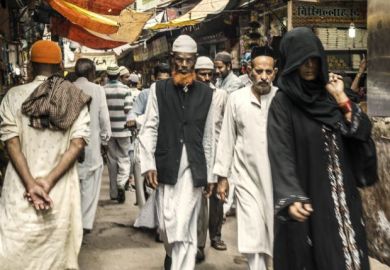A recent United Nations press release headlined the familiar adage that “education opens doors” – particularly for girls and women. In India, though, higher education provides a very unreliable key for graduates of both genders.
India’s economy is the fifth largest in the world and also among the fastest growing. But while economic growth commonly generates employment, India is said to be experiencing “jobless growth”. In addition, more than 90 per cent (and rising) of jobs are in the informal sector, and so are typically precarious and low-wage.
Reports indicate that highly educated Indians are more likely than the less educated to be unemployed, and that the number of unemployed graduates is rising. Indeed, the employment rate for young people as a whole (those between 15 and 24) has fallen significantly over the past decade and become quite low by global standards.
So even as larger numbers of young Indians – 43 million in 2020-21 – seek degrees in the hope of securing a better life, they often remain un- or under-employed and in debt. Nearly 50 per cent of them are considered unemployable.
One reason is that a large number of Indian universities and colleges hand out worthless degrees that add very little value to students’ knowledge and skills levels.
Another is that there is a mismatch between the skills students do acquire and those required by employers. This leaves graduates looking for jobs that do not exist, while many of those that do remain unfilled because employers cannot find people with appropriate skills.
A further problem is that college education has – despite its mediocre quality – raised expectations among young people about their future prospects. Hence, graduates who can afford to do so – sometimes barely, and usually when their parents are able to support them – choose to remain unemployed and even stop looking for work rather than take a job they do not consider commensurate with their degrees.
India’s “jobs crisis” comes at a time when its youth bulge is bigger than ever. The government is mindful of the challenge even though it is downplaying the unemployment problem to avoid a political backlash in the 2024 parliamentary elections.
For both the government and its critics, the solution seems to lie in promoting vocational education and training (VET) in lieu of, or in addition to, traditional college education. The reasoning is that sectors such as construction are booming, creating a demand for various skills that can be better provided through VET. But these are the kinds of jobs that college-educated Indians look down on.
It is estimated that less than 5 per cent of Indians between 19 and 24 currently receive formal vocational education. This is in part because, as stated in the 2020 National Education Policy (NEP), “vocational education is perceived to be inferior to mainstream education and meant largely for students who are unable to cope with the latter”. The NEP therefore calls for “a complete re-imagination of how vocational education is offered” through integration “into all schools and higher education institutions”.
But the NEP is in the early stages of implementation, and how this aspiration can be realised is yet to be figured out. Changes to neither institutional architecture nor public attitudes will come quickly or easily.
The other obvious challenge lies in improving the quality of existing VET provision at institutions such as industrial training institutes (ITIs). There are nearly 15,000 of these – both public and private – and while a small number enjoy a good reputation, most are plagued by many of the same problems as colleges and universities – notably, outdated curricula, poor infrastructure and lack of qualified teachers.
The government has also been running various skilling and reskilling programmes aimed at addressing the deficits of those with vocational or even professional degrees. But the programmes' achievements have been limited.
There is no doubt that some combination of VET and traditional college education is the right way to go. But even more crucial is to improve the quality of training and education at both vocational and traditional degree-giving institutions.
In the meantime, ever larger numbers of young Indians will graduate only to find that the doors they expected to open for them remain firmly closed.
Pushkar is director of the International Centre, Goa, and a member of the Academic Council at J. K. Lakshmipat University (JKLU).
Register to continue
Why register?
- Registration is free and only takes a moment
- Once registered, you can read 3 articles a month
- Sign up for our newsletter
Subscribe
Or subscribe for unlimited access to:
- Unlimited access to news, views, insights & reviews
- Digital editions
- Digital access to THE’s university and college rankings analysis
Already registered or a current subscriber?




